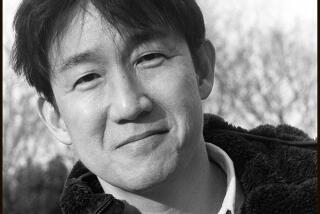How COVID and an antique marriage bed inspired Lisa See’s new historical novel

On the Shelf
Lady Tan’s Circle of Women
By Lisa See
Scribner: 368 pages, $28
If you buy books linked on our site, The Times may earn a commission from Bookshop.org, whose fees support independent bookstores.
Lisa See lives in Brentwood, but the novelist’s earliest memories are in Los Angeles’ Chinatown, where her father’s family owned one of the longest-running antique businesses in the city (F. Suie One, now in Pasadena).
For the record:
4:28 p.m. June 5, 2023An earlier version of this post said Lisa See lives in Pasadena. She resides in Brentwood. It also incorrectly called the 1871 massacre in L.A.’s Chinatown the largest mass lynching in history.
“I stayed with my grandparents a lot,” says See, speaking from her home office via Zoom. “I would go with them to work in the store, in what was the last remaining building of what had once been called China City, one of California’s first amusement parks.” The park, surrounded by its own mini-Great Wall, was plagued by fires and eventually shut down for good. But it lives in See’s memory, containing “all these rooms with different kinds of things — the bronze room, the ceramics room, and more.”
One of the store’s grandest items, a 16th century marriage bed, has inspired See’s 12th novel, “Lady Tan’s Circle of Women.” Based on the history of a young noblewoman, Tan Yunxian, who receives training as a physician from her maternal grandparents, the novel depicts Lady Tan inheriting the large, intricate bed from her mother. Such beds, which featured numerous “rooms” and compartments, also had space at the foot for a servant’s sleeping roll.
See and her cousins would play in and around the bed, which still resides at the family store. “At the end of the day, three of the four brothers and my great aunt, who all worked there together, would sit in an alcove right off the front door and have a drink and snacks and tell stories. They were pretty incredible storytellers, and they had a group of artist friends who included Tyrus Wong and Benji Okubo, and everyone was always trying to one-up each other.” These long afternoons did more than spark See’s interest in Chinese culture — they meant she was part of that culture.

For a woman who is one-eighth Chinese (her mother was the writer Carolyn See), this was important. “In Los Angeles alone, we had about 400 relatives, and of them about a dozen looked like me,” says See. “There was a spectrum in between too. When I looked around I saw Chinese tradition, Chinese celebrations, Chinese food. As a kid I didn’t see myself as different because they were my only mirror. It wasn’t until later that I learned they referred to me as ‘the little white ghost girl.’ But they also said, ‘We knew who you belonged to. You belonged to us.’”
See’s first novel, 1995’s “On Gold Mountain,” represented her attempt to understand her Chinese family’s history. Three mysteries followed; it wasn’t until 2005’s “Snow Flower and the Secret Fan” — “absolutely my breakout book” — that she discovered how much she loved to research. “It’s my favorite part of the process,” she says.
Historical fiction may be See’s preferred medium, but she’s come to believe its intensity might require an empty nest. “It hasn’t escaped my attention that I wrote ‘Snow Flower’ when my youngest son went away to college,” she says. “It’s not that I didn’t have time while raising my children, it’s that there’s a part of your mind that is always thinking about family management. Like Lady Tan, who winds up running a household with around a hundred people living in it.”
Lady Tan lived to be 96, “extraordinary even now,” says See. “One of the things the nephew who wrote up her cases noted is that she had become so expert later in life that she was like one of those doctors who could see through your body and diagnose you.”
The author of ‘The Island of Sea Women’ joins Times readers on Jan. 25.
We also know that both of Tan’s grandparents were doctors; in the book, they disagree about which kind of medicine Tan Yunxian should be trained to practice. Male doctors dealt with Blood as a concept but almost never touched or even saw their patients — particularly women, whose monthly periods and childbearing associated them with small-b blood, considered dirty, vulgar and base.
Fortunately for Lady Tan, her grandmother sees a rare opportunity to foster a friendship between her and Meiling, the daughter of midwife Shi — a friendship that might cement a sort of dual practice. As a physician, Tan Yunxian’s credibility would lend the practice status, while Meiling’s work in childbirth would bring it plenty of money. “If you delivered the future emperor, for example, you could be taken care of for life,” says See.
While writing about Ming dynasty reproductive medicine, See was well aware of the strictures placed on women at that time — and in our own. “We tend to learn the history of the front line, like wars and dates and presidents and generals,” she says. “But if you take one step back, who’s there? It’s the women. It’s the children. It’s families. We’re seeing that right now in Ukraine, and in the Middle East, anywhere that is in conflict. Women still go out to the marketplace, make sure their children are fed and clothed and educated, that they feel safe, that they hear stories. It’s those things that keep a society together.”
And crucially, Lady Tan’s profession serves human needs that cross all boundaries of wealth and class. “All the women of different ranks in history are living very different lives, but when it comes down to our reproduction, it doesn’t matter if you’re the empress or a servant,” See says. “You’re still going to get your period, you’re still going to go through years of fertility and years of menopause. And the thing we all share is that men have been wanting to control our experiences from Day 1. We see that happening right now across our country.”
95 writers with deep ties to Los Angeles weighed in on the L.A. books that affected them most. Beyond our big list, here are some of their greatest insights
See has found a groove in historical fiction that she will continue exploring; her next project will center on the 1871 massacre of Chinese immigrants in L.A.’s Chinatown, one of the largest mass lynchings in U.S. history. What links all her historical work, from “Snow Flower” to the new novel and beyond, is a distinctive combination of freedom and isolation — even, or especially, when that isolation is enforced.
“When I started ‘Snow Flower’ I was recovering from a concussion and couldn’t drive for six months,” she says. “When I started ‘Lady Tan,’ we had just entered the pandemic — and we could drive, but we couldn’t see other people for months. Somehow, although that was difficult for me, being so restricted, it also allowed me a kind of creative freedom.”
Those situations also remind her of playing around that antique marriage bed, a place of communion and solitude, safety and history, where her imagination could run wild.
Patrick is a freelance critic, podcaster and author of the memoir “Life B.”
More to Read
Sign up for our Book Club newsletter
Get the latest news, events and more from the Los Angeles Times Book Club, and help us get L.A. reading and talking.
You may occasionally receive promotional content from the Los Angeles Times.








